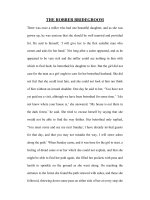The European tradition (1)- a well-known tale
Bạn đang xem bản rút gọn của tài liệu. Xem và tải ngay bản đầy đủ của tài liệu tại đây (96.68 KB, 7 trang )
14
Text © Sagrario Salaberri Design and illustration © Macmillan Publishers Ltd 1995
The European tradition (1):
a well-known tale
The Pied Piper of Hamelin
The Pied Piper of Hamelin is a famous European tale which has been passed from
generation to generation in both written and spoken form. Hamelin is a town in
north Germany where the action is supposed to have taken place. The tale is famous
all over the world and so the class are likely to already know it.
Activity 1
First, get the class to tell you what they can remember about the story but allow
them to use their own language rather than English. They will probably have their
own version of the story which you can later compare with the one which follows.
The ending of the story may cause some disagreement as some versions do not
mention the lame boy who acts as a messenger to the town and tells the people
what has happened to the other children. The version which follows includes this
episode and so make sure the class know the whole story in their own language
before telling it in English.
Once everyone has agreed on the content of the story, divide the class into groups
and ask them to make flashcards showing the characters and places in the story in
preparation for the storytelling session itself. These flashcards should be large
enough to be seen from the back of the classroom. The following characters and
places need to illustrated: the mayor, the piper, the townspeople, the children, the
rats, the lame boy, the town, the river with a bridge and the mountain.
2
Before you
read
Text © Sagrario Salaberri Design and illustration © Macmillan Publishers Ltd 1995
15
CHAPTER 2 The European tradition (1): a well-known tale The Pied Piper of Hamelin
CHAPTER 2 The European tradition (1): a well-known tale The Pied Piper of Hamelin
Activity 2
Present the following characters in the story to the class in English using the
flashcards.
The Mayor The children
The Pied Piper The rats
The townspeople The lame boy
There may be a problem in knowing what to call the piper in the story in that he is
called the Pied Piper in the title. Explain the meaning of pied (multi-coloured,
wearing brightly coloured clothes). One other word which may need explanation is
the compound townspeople which is an archaic literary word for inhabitants. It can
simply be substituted by the word people.
Get the class to tell you in English about where the story takes place: in the town of
Hamelin, surrounded by a river and with a mountain to the east.
Show the class the flashcards which correspond to these places. As an extra activity,
you can ask one of the class to locate Hamelin in an atlas.
Ask the class questions in English such as:
How many main characters are there in the story?
Where does the story take place?
Where is the mountain?
How do you say ‘mayor’, ‘townspeople’, ‘piper’, ‘lame boy’, ‘rats’ in your
own language?
Now tell the story to the class but do not expect them to understand everything the
first time they listen. Try to make the story come to life and use your voice and
gestures to get across what happens in the story. Mime the physical action in the
story: run after, jump into, walk across, etc. Help clarify meaning by holding up the
appropriate flashcard when the characters or places are mentioned in the story.
Focus on some of the more difficult language in the story: tune, drown, get rid of,
should have, etc. You can write the words on the board with their translations
before you begin the story and allow the class to ask questions when they do not
understand.
The story is written in the present simple for ease of comprehension. Stories with
reported speech create an added problem for low level learners. The story has been
divided into thirteen sections for ease of understanding and for use in follow-up
activities.
While you
read
16
Text © Sagrario Salaberri Design and illustration © Macmillan Publishers Ltd 1995
Text © Sagrario Salaberri Design and illustration © Macmillan Publishers Ltd 1995
17
CHAPTER 2 The European tradition (1): a well-known tale The Pied Piper of Hamelin
T
HE
P
IED
P
IPER OF
H
AMELIN
This is the town of Hamelin. It is a town in Germany. They have a big
problem – there are rats everywhere!
The townspeople say, ‘There are rats everywhere! We will go to see the
Mayor. He must help us.’
The Mayor says, ‘I don’t like rats, but what can I do? I cannot make the
rats go away.’ The townspeople are angry.
A strange man arrives in town. He wants to see the Mayor. The strange
man is the Pied Piper.
The Pied Piper says to the Mayor, ‘Will you give me some money if I get rid
of the rats?’
The Mayor says, ‘Yes, of course.’ The Pied Piper is happy.
The Pied Piper plays a tune. Suddenly, all the rats in town are running after
the Pied Piper. They all come running after him. He walks into the river.
All the rats jump into the water and drown.
The Pied Piper says to the Mayor,‘There aren’t any rats anywhere. Please
give me my money.’
‘No,’ says the Mayor. ‘Go away! We do not want you here. I will not give
you the money you want.’
So, the Pied Piper plays a different tune. The children like the tune that the
Pied Piper is playing.
Suddenly all the children are running after the Pied Piper. There is also a
lame boy who cannot run very fast. They walk across the bridge.
They come to a mountain but they do not stop. The mountain opens up.
The Pied Piper walks into the mountain and the children walk in after him.
The lame boy wants to walk in too, but the mountain quickly closes up.
The boy goes home.
There are no children in Hamelin. Only one. The Mayor should have paid
the Pied Piper.
18
Text © Sagrario Salaberri Design and illustration © Macmillan Publishers Ltd 1995
CHAPTER 2 The European tradition (1): a well-known tale The Pied Piper of Hamelin
Tell the story a second or even a third time until the class have understood the
whole thing.
Activity 1
The class can do this activity as a task while you read the story, preferably during the
second reading. It can be used as a comprehension check of the story as much as an
aid to following the story. Give out copies of the Who does what? activity which
appears on the next page. Get the class to decide which of the three characters in
the left-hand column performs the action on the right. Make sure the class
understand they have to focus on who does what at each stage of the story. Another
way of exploiting this activity is to divide the class into groups of three and hand out
the names of each of the characters written on card. The class should hold up the
correct card every time they hear their character mentioned in the story.









